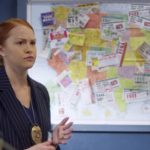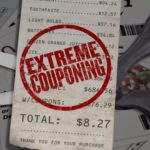
Remember when grocery shopping, couponing and stockpiling was like an extreme sport?
A guilty pleasure to some, and a thorn in the side to others, it’s hard to believe it’s been exactly ten years since the debut of Extreme Couponing, which hit the airwaves as a one-hour special on TLC on December 29, 2010.
A whole lot has changed in the decade since. Some changes, like more restrictive coupon policies, were a direct result of the show, while other changes are due to technological advancements since then, like the rise of digital coupons and rebate apps.
But back then, a show about people cutting out slips of paper to save serious money struck a chord, becoming a weekly series, a phenomenon, a can’t-miss curiosity for flabbergasted observers, and an irritant to less-extreme savers and the coupon industry, who said it gave couponers a bad name.
Much of that, though, came later. Before the shopping trips on the series became increasingly outrageous, unrealistic and fraught with coupon fraud, a simple one-hour show about uniquely-obsessed savers captivated incredulous viewers who wondered whether the show’s participants had a screw loose – while secretly wondering how they, too, might be able to get shopping carts full of groceries for free.
The Extreme Couponers
Four couponers were featured on that first special. So Coupons in the News reached out to them all, to discuss their experiences, their memories and regrets, and to find out how much couponing has changed for them since then. Two of the show’s participants are still very much into coupons, while two have moved on and would rather not even talk about coupons anymore – which seems somehow appropriate for a show that, upon its debut, generated opinions split right down the middle.
Looking back at the show with a decade’s worth of perspective, “Extreme Couponing, the way it was shot before, could not happen,” participant Joanie Demer told Coupons in the News. “A show where people go in and buy heaping cartloads and dozens and dozens of the identical product at the same time, if not hundreds – that’s no longer possible.”
Demer’s search for discarded coupon inserts was one of the indelible images of that first episode (“I’ve only ever dumpster dove for coupons once, with TV cameras!” she insisted). That was but one example of the show’s heightened version of reality, designed to display the lengths to which some couponers would go in order to save.
While it wasn’t mentioned on the show, Demer was, and is, the co-founder of The Krazy Coupon Lady website, and had already made a number of media appearances alongside co-founder Heather Wheeler – which is how Extreme Couponing producers found her. Joyce House had a similar story. “Prior to the show I was on a local TV show sharing saving tips,” the owner of the Miss Coupon Diva website told Coupons in the News. Nathan Engels, then-owner of the site We Use Coupons, had also been featured on various TV segments as a couponing expert, and his friend Amanda Ostrowski rounded out the original foursome.
Reality TV producer Matt Sharp of Sharp Entertainment saw these media appearances and news stories about couponers, and the topic “piqued our interest,” he told the New York Times in 2011. “There’s a show here,” he thought. “It’s doing two things at once: It’s tapping into the unbelievable, yet it’s also relatable.”
That’s how it was pitched to the participants. But plans changed between the initial idea and the execution.
Unreality TV
“We had tried to work with the production company to make more of a ‘how to coupon,’ almost like a ‘What Not to Wear,’ where we make over your budget and show you how to save on groceries,” Demer said, in alignment with the mission of The Krazy Coupon Lady, then and now. But the show as aired “had become just the shock, and it wasn’t showing people how to do it.”
“I have had the same feelings about the show. I wanted to educate and they were only interested in entertainment,” House said. “The way you are portrayed on the show was not realistic. True couponers do not shop the way shown.”
Engels, who sold We Use Coupons several years ago, then started and sold a food blog, and now describes himself as “a digital strategist, healthcare marketer and international speaker on digital marketing and trends,” did not respond to requests for comment about his past as an extreme couponer. And Ostrowski declined to participate in a story, saying that she, too, has moved on.
But in earlier interviews, the two echoed their counterparts’ comments about the unreality of reality TV. “The purpose of the show was to get your attention, and was the most extreme side of shopping that I’ve ever done,” Ostrowski told the website Cincy Chic in 2012. “I am not really an ‘extreme couponer,’ because I don’t really shop like that.”
“If I was editing it, I would have done it a little differently, but it’s TV,” Engels told the website Saving Dollars & Sense in 2011. “The TLC producers asked for an extreme shopping trip and that’s what they got from me. I’m a pretty normal coupon shopper.”
“I bought four shopping carts worth of stuff… That shopping trip was completely insane!” Demer remembered with a laugh about her televised grocery haul. “I took months to plan for it. I wrote to manufacturers and got free product coupons that I saved up.” In the end, “it’s fun to flex your muscles and get to say, look what I can do… That’s cool and it made for great TV,” she said. But “that was in no way a realistic portrayal of the amount of money that you can save on any given week couponing.”
TV reviewers unfamiliar with couponing didn’t seem to know what to make of that first hourlong special. “It’s official: Anything can be made into a television show,” the Austin American-Statesman scoffed. The Charlotte Observer said the show “blurs the line between saving money and addiction,” while ABC News called the four shoppers obsessive and wondered whether they were unstable. And the New York Times called the participants “part of a shockingly large community of over-the-top cost cutters” who demonstrated “the psychosis of acquisition, under the guise of smart savings.”
But viewers, who weren’t haughtily practicing armchair psychology, loved it. More than two million tuned in, which made the show a big hit by basic cable standards. That prompted the network to order the first of several seasons’ worth of follow-up episodes that began the following April.
And that’s when an entertainingly-over-the-top show became something more problematic.
Extreme Couponing gets a little too extreme
The original special skirted with controversy, by making several favorable references to online “coupon clipping services,” many of which peddle mass quantities of illicitly-obtained coupon inserts from intentionally-unspecified sources. But the series pushed the boundaries of acceptable – and legal – coupon usage even further.
The four original participants didn’t really know what they were getting into, believing they would be part of an educational show about how to save money with coupons. But many participants in the series, who had seen the original special, knew full well what they were getting into – and gave the producers just what they wanted. In the quest for ever-more outrageous shopping hauls, many who were featured in the series were shown misusing coupons, knowingly using them on the wrong products, and using high-value coupons they bought online, many of which turned out to be counterfeit. And stores that normally imposed purchase limits or double-coupon caps for normal shoppers, waived their rules for the benefit of TV.
North Carolina-based Lowes Foods publicly expressed regret for allowing an episode to be recorded in one of its stores. “Some of what appears in the clip you saw was staged by the production company,” the retailer said in a 2011 statement. “Things aren’t as they always appear. We definitely made a poor decision by participating in the show.”
The Coupon Information Corporation, which represents the coupon industry, condemned the “potentially illegal acts that appear to have been portrayed on the show” and urged producers to “reconsider their path and seek to turn this into a show that accurately reflects appropriate coupon strategies and use.” And blogger and syndicated coupon columnist Jill Cataldo wondered “what kind of scrutiny are people like you and me going to face at the register, when cashiers assume ‘those darn coupon shoppers’ are trying to put one over on the store?”
TLC and Sharp Entertainment deflected blame for any unethical or illegal acts depicted in the series. “This is a docu-series of behaviors; it’s not a how-to program,” TLC spokesman Dustin Smith told Supermarket News. “It’s up to each of the couponers to follow store policy and coupon rules,” Sharp told the Chicago Tribune.
Stores and manufacturers began imposing new limits to discourage anyone from trying to emulate what they had seen on TV. “The show made companies impose stricter rules and decreasing limits of coupons. Many store owners became hostile towards couponing,” House said. “I truly wanted to teach. Help people who were struggling to support their families. Unfortunately, many took it as an opportunity for another hustle.”
Extreme Couponing’s end
By its fourth and last season in late 2012, Extreme Couponing producers seemed to tone down the outrageousness, focusing on more personal stories and modest hauls. But by then, viewers had largely moved on to other things. The series’ last episode attracted only about one-quarter as many viewers as the first, and the show quietly faded away into the land of reruns.
Sharp Entertainment declined to comment on the show’s impact and legacy, saying it is too “tied up on current productions” to dwell on the past. Others reflecting back on that time, are divided over whether the show had any positive impact in the long run. Engels said it was “good television” and got people’s attention, and “when I have your attention, I can teach you.” House also teaches people how to use coupons effectively, and said not much has changed for her. “I still save as much, since I still shop the same,” she said. Demer said the show was educational, to an extent, in that it “led a lot of people to a path to save actual money.” But “the show was crazy and it was totally a mix. Was it potentially a necessary evil? You know, I don’t know.”
“We watched that show very closely, and I really couldn’t think of anything positive that came out of it,” Coupon Information Corporation Executive Director Bud Miller told Coupons in the News. “Most couponers are honest, and we always want to give people the benefit of the doubt,” he said, but “the show gives couponers a bad name, and that’s just a very sad outcome.” And even though the last original episode aired eight years ago, “the fallout continues to this day.”
While couponing changed in many ways as a result of the show, some of the biggest changes between couponing back then and today have nothing to do with Extreme Couponing at all. Nowadays, you may not be able to use dozens of coupons to get 62 bottles of free mustard if you’re so inclined, but “think of all of the ways that you can save,” Demer said. “Stacking a purchase-based $10 off $30 beauty purchase with Target Circle offers and everything that you can do digitally, and then using an Ibotta offer after the fact. That’s pretty crazy. And I think a lot of us would have killed for that back in the day.”
And, while ten years is a long time for most of us – to younger shoppers just getting into coupons, it’s an eternity. “What we’re seeing on Krazy Coupon Lady is a generation of couponers that never watched the show, that aren’t even really aware of it,” Demer said. “They’re not coming from this jaded, ‘oh, it used to be like this, and now it’s like this.’ It’s been interesting to kind of watch that happen.”
So could it be that so much has changed since 2010, and so much time has passed, that Extreme Couponing hasn’t left much of a legacy at all? Much of reality TV is of the moment, after all. It’s a fleeting, disposable form of entertainment – when was the last time you even thought about Honey Boo Boo or Joe Millionaire, if you ever did?
Debuting in the aftermath of the Great Recession of 2008 as it did, when saving money was at the forefront of people’s minds, Extreme Couponing may have been a product of its time. “If you had put this show on before the economy took that downturn, I’m not sure that it would have resonated the way that it did,” Amy Winter, then-general manager of TLC, told the New York Times in 2011.
Of course, the economy today has taken another turn for the worse, for entirely different reasons. And many who are hurting financially may discover a newfound interest in coupons. “Couponing is still exciting,” Demer concluded. “I don’t think that there’s ever going to be a day where there’s not a way for those who are smart and strategic to spend a little bit of extra time and save money.”
So Extreme Couponing may have passed its expiration date. But couponing itself is alive and well. It may not be quite the same as it was back then – but maybe that’s just as well.











Yeah, couponing now stinks! I started coupon shopping for my house when I was 12. We lived in an apartment complex that was less than 2 blocks from a large grocery store & everyone got the Sunday paper & tossed the coupons.
My mom gave me $10 & asked me to run over & get a gallon of milk, cereal & 1 or 2 other items and said sarcastically that I could keep the change as a reward for walking over & getting everything. When I came back with everything she asked for & $8 & some change not only was she shocked, but I was hooked on couponing for life!!
30 years later and you now can’t use more than 4 of the same coupon per day because of this show!! While the TV show was fun to watch, it ruined couponing for all of us that relied on it to feed our families at a fair price & monopolize on sales!
What happened to Cris? The guy studying to be a minister?
What a great article! THANK YOU! ♥️
Even though the show was VERY entertaining – it DID screw things up for a lot of us regular couponers – myself included…. 🙁
I wish couponing would go back to before Extreme Couponing tv show.Things weren’t great with the number of coupons available in Canada but way worse now.Coupon inserts basically disappeared.Cashiers try to scan manufacturer coupons when Canadian coupons don’t scan.You use two coupons then some cashiers ask if you’re an extreme couponer.I know coupons can’t go back to the way they were.